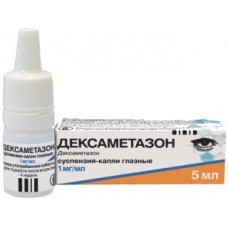Expiration date: 05/2026
Release form and composition:
Eye drops 0.1% suspension of white color, the possible presence of sediment, which quickly resuspendiruetsa with mild agitation.
1 ml contains:
dexamethasone 1 mg
Auxiliary substances: Polysorbate 80, hypromellose (hydroxypropyl methylcellulose 4000), disodium phosphate dodecahydrate, citric acid monohydrate, sodium chloride, disodium edetate dihydrate, benzalkonium chloride, purified water.
10 ml dropper bottle polymer (1) - packs of cardboard.
Pharmacological action:
Corticosteroids for local application in ophthalmology. Has a pronounced anti-inflammatory, antiallergic and antiexudative action.
Interacting with specific protein receptors in target tissues, regulates the expression of genes is affected corticogenesis and thus on protein synthesis. Reduces the formation, release and activity of inflammatory mediators (including histamine, kinin, prostaglandins, lysosomal enzymes).
Inhibits the migration of cells to the site of inflammation. Reduces vasodilation and increased vascular permeability in inflammation. Stabilizes lysosomal enzymes in the membranes of leukocytes. Suppresses antibody synthesis and disrupts the recognition of antigen. Inhibits the release of interleukin 1 and interleukin 2, gamma-interferon of lymphocytes and macrophages. Induces the formation of lipocortin, inhibits the release of eosinophils mediators of inflammation and stabilizes the membranes of fat cells. All of these effects are involved in the suppression of inflammatory reactions in the tissues in response to mechanical, chemical or immune damage.
Duration of anti-inflammatory action of the drug after instillation of 1 drop of the solution is from 4 to 8 p.m.
Pharmacokinetics:
Absorption and distribution
After instillation into the conjunctival SAC of dexamethasone penetrates well into the corneal epithelium and the conjunctiva, while in the watery moisture of the eye is achieved therapeutic concentrations. When inflammation or damage mucous membrane penetration rate increases.
Systemic absorption of the drug is minimal. About 60-70% of dexamethasone, entering into the systemic circulation, bound to plasma proteins.
Metabolism and excretion
Dexamethasone is metabolized in the liver under the action of zitohromoksidasy enzymes. Metabolites are excreted with the feces. T1/2 is approximately 3 h.
Indications:
- conjunctivitis (including purulent, allergic)
- keratitis
- keratoconjunctivitis (without damage to the epithelium)
- blepharitis
- scleritis
- episcleritis
- chorioretinitis
- uveitis
- blepharoconjunctivitis
- optic neuritis
- sympathetic ophthalmia
- prevention and treatment of inflammation after surgery and trauma
- restoration of corneal transparency and the reduction of neovascularization after keratitis, and burns.
Dosing regimen:
Adults
In acute inflammatory processes the drug buried in the bag kongungualny by 1-2 drops 4-5 times/day for 2 days later the drug is used 1-2 drops 3-4 times/day for 4-6 days.
In chronic inflammatory processes the drug is instilled 2 times/day for 3-6 weeks.
The maximum duration of the drug is 6 weeks.
In allergic diseases of the eye the drug is instilled into the conjunctival SAC 1-2 drops 4-5 times/day for 2 days with gradual abolition within 1-2 weeks.
In injuries of the eyeball as a result of injuries or during surgical interventions after protivoglaucomnoe filtering operation is used on the day of surgery or the next day.
After surgery cataract surgery, surgery for strabismus, retinal detachment surgery, and after injury the drug is used starting from 8th day. Depending on the severity of the inflammation symptoms the drug should be instilled 1-2 drops 2-4 times/day for 2-4 weeks.
Children aged 6 to 12 years
In the treatment of allergic and inflammatory conditions instill 1 drop 2-3 times/day for 7-10 days. If necessary, the treatment continues after a 10 day fluorescein samples (to check the integrity of the corneal epithelium).
Side effects:
Basically, the drug is well tolerated. With prolonged use may increase the risk of systemic side effects characteristic of SCS.
Local reactions
Immediately after instillation of the drug may quickly passing burning sensation, tearing, blurred vision.
In applying the drug more than 2 weeks may increase intraocular pressure glaucoma with damage to the visual nerve, reduced visual acuity and loss of visual fields, as well as the formation of back subcapsular cataract, thinning and perforation of the cornea very rarely spread of herpes and a bacterial infection.
In patients with hypersensitivity to dexamethasone or benzalkonium chloride can develop allergic conjunctivitis and blepharitis.
May develop itching, palpebral or conjunctival erythema.
With the appearance of ulcers of the cornea or sclera, the drug can slow healing and promote re-infection.
Systemic reactions
From the endocrine system: reduced tolerance to glucose, steroid diabetes mellitus or manifestation of latent diabetes, suppression of adrenal function, the syndrome Itsenko-Kushinga.
From the digestive system: nausea, vomiting, increased or decreased appetite, exacerbation of chronic diseases of the gastrointestinal tract.
From the side of cardiovascular system: arrhythmia, bradycardia, increased blood pressure.
CNS: increased intracranial pressure, nervousness or anxiety, insomnia, dizziness, and headache.
Contraindications:
- viral diseases of the eye
- fungal diseases of the eye
- suppurative eye disease (without concomitant antimicrobial therapy)
- trachoma
- increased intraocular pressure
- damage to the integrity of the corneal epithelium
- tuberculosis of the eye
- children up to age 6 years
- pregnancy
- lactation (breast-feeding)
- hypersensitivity to the drug.
Pregnancy and lactation:
The use of the drug in pregnancy, lactation (breastfeeding) contraindicated.
Special instructions:
The preparation is intended only for local use. It should not be used for intraocular injection.
Before application the preparation should be shaken.
If not marked improvement after 3-4 days of treatment, you should assign additional local or systemic therapy.
The medicine composition includes an antimicrobial preservative benzalkonium chloride which may be absorbed by soft contact lenses. Therefore, do not use the medicine while wearing soft contact lenses. You must remove the lenses before application of the drug and to establish no earlier than 15 minutes after backfilling.
When using the drug in combination with other ophthalmic drops, it is necessary to keep the interval between the instillation of at least 15 min.
Drug treatment may mask the picture of a bacterial or fungal infection, so the treatment of infectious eye diseases, the drug should be combined with appropriate antimicrobial therapy.
Dexamethasone may lead to false-positive test result for doping.
Effects on ability to drive vehicles and management mechanisms
Taking into account the possibility of tearing after instillation of drug should not apply it immediately before driving or operating machinery. Within 30 minutes after instillation of the drug should refrain from activities, require increased attention.
Overdose:
Overdose when used in ophthalmology is unlikely.
Symptoms: possible local manifestations. There is no specific antidote. The drug should be discontinued and appoint a simptomaticescuu therapy.
Prolonged drug use or use at high doses may increase the systemic absorption of dexamethasone, as well as the possible development of ocular hypertension and certain diseases of the cornea or the crystalline lens.
Drug interactions:
Long-term use of dexamethasone with idoxuridine possible strengthening of destructive processes in the epithelium of the cornea.
Dexamethasone may potentiate the effects of barbiturates.
The combined use of dexamethasone with phenytoin leads to decrease in the concentration of the latter.
Warfarin in combination with dexamethasone increases the risk of bleeding.
In normal mode, the local application of a dose insufficient to cause induction or saturation of hepatic enzymes.
With simultaneous use of dexamethasone with diuretics (especially thiazide and inhibitors of carbonic anhydrase) and amphotericin b may increase the excretion of potassium and increase the risk of developing heart failure.
With simultaneous use of dexamethasone with cardiac glycosides worsening their portability and increases the likelihood of developing ventricular arrhythmia (due to hypokalemia caused).
With simultaneous use of dexamethasone with ethanol and NSAIDs increases the risk of erosive-ulcerative lesions of the gastrointestinal tract.
The èstrogensoderža?imi estrogens and oral contraceptives reduce the clearance of dexamethasone, which may be accompanied by increased severity of his actions.
The combined use of antiarrhythmic drugs with dexamethasone may lead to decreased effect of the latter.
Terms and conditions of storage:
The drug should be stored out of reach of children, dry, protected from light place at temperature not exceeding 25°C. shelf Life - 3 years.
After opening the bottle the drug should be stored no more than 4 weeks.





